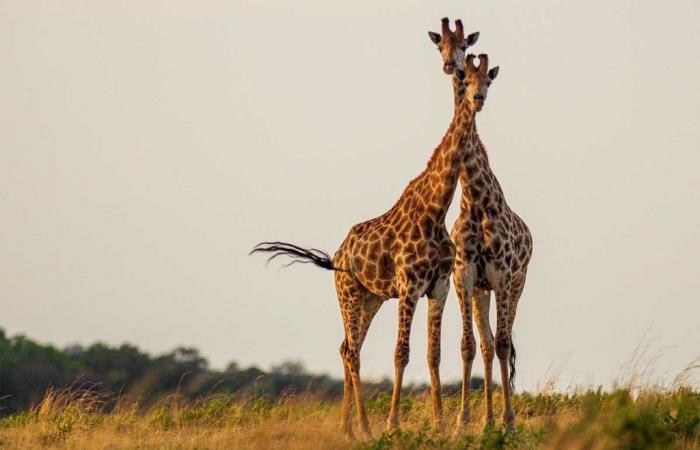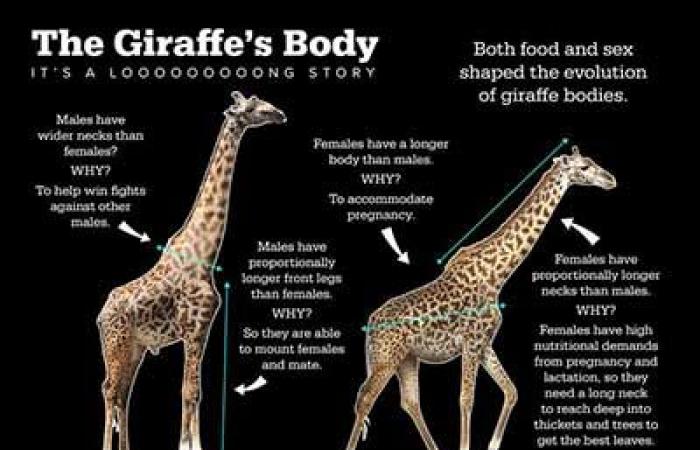Reaching the highest and deepest branches of trees to feed their offspring has been the reason why The neck of female giraffes is longer than that of males. This is now stated by American researchers from the American University of Penn State, who debunk the globally accepted hypothesis that competition between males influenced neck length.
In an observational study that appears in Mammalian Biologyled by Professor Derek Lee, senior researcher at the Wild Nature Institute, claim that, although males and females have the same body proportions at birth, they are significantly different when they reach sexual maturity.
Females have proportionally longer necks and bodies than males, which could help in searching for food for their young, while Males have wider necks and longer front legs, which could help them win fights against other males and in mating.
The scientists involved in this study examined the anatomical proportions of the neck, front legs, hind legs, and trunk of the Masai giraffe (G. tippelskirchi) in captive and wild specimens.
In their classic theories of evolution, Jean Baptiste Lamarck and Charles Darwin suggested that giraffes’ long necks evolved to help them reach the highest leaves on trees, avoiding competition with other herbivores.
However, a more recent hypothesis, known as necks by sexsuggests that The evolution of long necks was driven by competition between males, who swing their necks at each other to assert dominancewhat is called neck combat.
Hundreds of photographs of giraffes
According to this, males with longer necks could have been more successful in competition, which would have led to them reproducing and passing their genes on to offspring.
As J. Lloyd Huck, lead author of the study, points out, “technically they have longer necks, but everything about males is longer; They are 30% to 40% larger than females. “In this study, we analyzed photographs of hundreds of wild and captive Masai giraffes, to investigate the relative body proportions of each species and how they might change as they grow and mature.”
Because absolute measurements such as total height are difficult to determine from a photograph without a reference point of known length, the team focused on measurements relative to each other or on body proportions (for example, neck length in relation to the total height of the body).
They restricted their analysis to images that met strict criteria, such as only using snapshots of giraffes perpendicular to the camera, so they could take a variety of measurements consistently.
Doug Cavener, co-author, points out that “we can identify individual giraffes by their unique spot pattern. Thanks to the Association of Zoos and Aquariums, we also have the complete pedigree or family tree of all North American Masai giraffes in zoos and wildlife parks, as well as their birth dates and transfer history. So by carefully considering this information, when the photo was taken, and the approximate age of the animal, we were able to identify the specific individual in almost every photograph of a captive giraffe. “This information was critical to understanding when male and female giraffes begin to show size differences and whether they grow differently.”
Male and female giraffes
At birth, male and female giraffes have the same body proportions. The researchers found that although males generally grow faster during the first year, body proportions are not significantly different until they begin sexual maturity around three years of age. Because body proportions change early in life, the team limited their study of wild animals (whose ages are largely unknown) to fully grown adults.
In adult giraffes, they found that females have proportionally longer necks and trunks, or the main section of its body, which does not include the legs or neck or head. Adult males, on the other hand, have longer front legs and a wider neck. This pattern was the same for both captive and wild giraffes.
“Instead of reaching out to eat the leaves on the highest branches, giraffes, especially females, are often seen burrowing deep into the trees. Giraffes are picky eaters: They only eat the leaves of a few species, and their longer necks allow them to reach deeper into trees to obtain them. Once females reach four or five years of age, they are almost always pregnant and nursing, so we believe that Increased nutritional demands of females drove the evolution of their long necks”Adds Cavener.
The researchers noted that sexual selection (either competition between males or preference among females for larger mates) was likely responsible for the overall size difference between males and females, as is the case for many other large, hoofed mammals that are polygynous. ; That is, one male mates with many females.
Endangered specie
They suggest that, following the evolution of the long neck, sexual selection (including male body thrusting and neck fighting behaviors) may have contributed to males having wider necks. Besides, their longer front legs may aid in matingwhich researchers say is a brief and challenging issue that is rarely observed.
Cavener clarifies that, curiously, giraffes are one of the few animals “whose height we measure to the top of the head, like humans, instead of to the withers, the highest part of the back, as in horses and Other animals. The female has a proportionally longer axial skeleton (a longer neck and trunk) and a more sloping appearance, while males are more upright.
This Penn State team also uses genetics to identify relationships in groups of wild giraffes, to better understand which males are successful at reproducing. The goal is to shed light on mate choice and sexual selection.as well as guide conservation efforts for this endangered species.
“If female foraging drives this iconic trait as we suspect, it really highlights the importance of conserving their shrinking habitat. Masai giraffe populations have declined rapidly over the past 30 years, partly due to habitat loss and poaching. It is essential that we understand the key aspects of their ecology and genetics, to design the most effective conservation strategies to save these animals,” concludes Doug Cavener.









